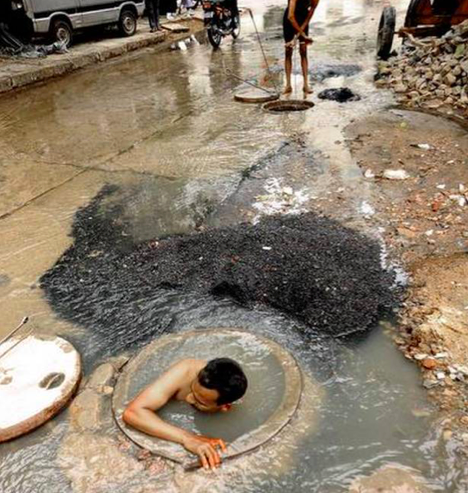India shining or stinking? dr. james kottoor (Chicago)

 What about manual scavenging?
What about manual scavenging?
Swachh Bharat Abhiyan was and is one of the most beautiful ideas piloted by PM Narendra Modi. But it has still a long long way to go before its most ugly, dirty, shuddering, stinking truth hiding behind it can be erased fully. Similarly cow protection is a beautiful idea caring for domestic animals but slaughtering humans at the whims and fancies of cow vigilantes is not. It is the most crazy, deadly and cruellest of jokes.
Joining hands with world leaders to fight terrorism and blood shed at all hot spots around the globe is admirable and praise worthy and Modi does it superbly on all his foreign trips, but if it is done at the cost of allowing terror, blood shed and murder of innocents to run riot in one’s own country, such a leader will automatically become the object of ridicule and ill-repute. Words with out actions are bound to boomerang on any leader who gives out diktats but cares too hoots to see them executed.
Manual scavenging is one of the dirtiest, foul smelling and suffocating work to be done by humans in any part of the world in this day and age. Civilized nations abhor it. According to reports in the Hindu there are about 2.6 million insanitary latrines that require cleaning by hand. Due to inhaling poisonous gas from overflowing human faces many have succumbed to death in Madurai while dong this work and so the government of India had officially banned manual scavenging already in 2013. No one would believe that the practice still continues in India even today. So Divya, a law graduate and social worker has made a documentary called ‘Kakkoos,’ of the actual work done by a lady worker and is produced below. Seeing is much more than believing blindly. Those visuals clearly prove that the government is lying when it says that scavenging is now mechanized. Some of the low castes among the Dalits who do this work are Kaatu Naicker, Chakiliyar, Irular, Kuravar and many others. In the absence any better work available, these poor sections of the Dalits are forced to do it for a living. Job creation is one of the promises made by Modi Sarkar. For a country which prides itself to be a democracy, the first place to create dignified jobs for humans is to provide machines to replace manual scavenging.
There is no use blaming Modi personally for what is happening in this area. May be he is not even aware that this is happening in India in this day and age. It is here that dailies like the Hindu does a yeoman service by highlighting the detestable practice. It is the duty of print and visual media to bring this kind of shameful practices to the notice of those in authority so that remedial steps would be taken on a war footing. Let us hope that this happens at least in the case of manual scavenging in India. Putting a full stop to it on the ground would be the first bold step towards creating a Swachh Bharath. Let us make India shining, not stinking! james kottoor, editor.
Please read below the Hindu Editorial on the subject Get real on Swachh: on manual scavenging EDITORIAL IN THE HINDU, JULY 19, 2017 MORE-IN Responsibility must be fixed on State governments to end manual scavenging.Despite the most stringent penal provisions in the law against manual scavenging, it continues in parts of India.
The recent order of the Madras High Court asking the Centre and the Tamil Nadu government to ensure the strict enforcement of the Prohibition of Employment as Manual Scavengers and their Rehabilitation Act, 2013, in the wake of the death of 30 people engaged in the activity in the State in recent years, points to the malaise. Evidently, the vigorous national campaign for the rehabilitation of those engaged to manually clean insanitary latrines, and urban structures into which human excreta flows without sewerage, has been unable to break governmental indifference and social prejudice. Manual scavenging persists mainly because of the continued presence of insanitary latrines, of which there are about 2.6 million that require cleaning by hand, according to the activist organisation, Safai Karmachari Andolan. In spite of a legal obligation to do so, State governments are not keen to demolish and rebuild old facilities lacking sanitation, or conduct a full census of both the latrines and the people engaged in clearing such waste.
The Central government, which directly runs the self-employment scheme for the rehabilitation of these workers, has reduced funds from ₹448 crore in the 2014-15 budget to ₹5 crore this year. High allocation in the past has not meant substantial or effective utilisation. This is incongruous, as sanitation is high on the agenda of the NDA government, and the Swachh Bharat Abhiyan is one of Prime Minister Narendra Modi’s favourite programmes, to which the public was contributing a cess. A determined approach to end the scourge requires a campaign against social prejudice that impedes solutions in two ways. Many communities still regard the inclusion of a sanitary toilet as ritual and physical pollution of the house, and even the less conservative are ready to accept only large, expensive and unscientific structures much bigger than those recommended by the WHO. More pernicious is the entrenched belief in the caste system, that assumes Dalits will readily perform the stigmatised task of emptying latrines. Clearly, the law on punishment exists only on paper. Change now depends on the willingness of the courts to fix responsibility on State governments, and order an accurate survey of the practice especially in those States that claim to have no insanitary latrines or manual scavenging. Raising the confidence level among those engaged in manual cleaning is vital; even official data show their reluctance to take up self-employment. Empowerment holds the key to change, but that would depend on breaking caste barriers through education and economic uplift. Compensation sanctioned for the families of those who died in the course of the humiliating and hazardous work should be paid immediately; only a fraction of those with verified claims have received it.
Featured picture exposes a dirty, ugly Truth of manual scavenging In Tamilnadu
CHENNAI:FEBRUARY 27, 2017 ‘Kakkoos,’ a documentary made by a woman film-maker, says manual scavenging never disappeared. A public toilet comes sharply into view. Around the human waste there, sanitary napkins lie scattered, along with dead rats and other animals. A woman sanitary worker, using two sticks as tongs, collects them. At times, she is forced to pick them up by hand and make a heap before setting it on fire. Coughing constantly as smoke and fire emerges from the heap, she leaves the spot. This scene from Kakkoos, a documentary released on Sunday, portrays the miserable lives and working conditions of conservancy workers who are forced to do manual scavenging in almost every part of Tamil Nadu. There are many such scenes, including those of workers wearing just flip flops and cleaning public toilets and open drains overflowing with faeces. There are also instances where the human waste is cleared with bare hands.
“The government reels out statistics to deny the existence of manual scavenging and claims that machines have replaced human beings when it comes to entering manholes and removing other hazardous wastes. But the reality in the film completely proves that the government is lying,” said Divya, a law graduate, who has made the film. The documentary, shot in 25 districts for over a year, conveys the message that even though manual scavenging was banned in India in 2013 it continues to exist and conservancy workers are involved in removing human waste. The film is dedicated to those who maintain a “false silence on manual scavenging.” “I decided to name the film Kakkoos as it will carry the message directly,” said Ms. Divya.She said she came to see their plight while fighting on behalf of the families of workers who were fatally asphyxiated in Madurai. “How could a person like me wedded to the Marxist-Leninist ideology throw a blind eye to the people living on the margins of society,” said Ms. Divya, when asked what prompted her to make the film. The documentary-maker said the definition of “manual scavenger” in the Prohibition of Employment as Manual Scavengers and their Rehabilitation Act 2013, was inadequate and the film drives home the point.
A woman worker in the film says, “As a sweeper, my work is only to remove the garbage. But the streets are littered with human waste and I cannot refuse to clean them.” The film emphasises that cleaning toilets covered by walls is far more hazardous and inhumane, than removing human waste from open areas. “I throw up constantly. What I see haunts me throughout the day,” says a worker. “My daughter refuses to take anything from my hand,” laments another woman. The film explains that it is not just members of the Arundathiyar community who are involved in manual scavenging. Kaatu Naicker, various sub-sects of Dalits, Chakiliyar, Irular, Kuravar and many other communities are also forced to do it.
















